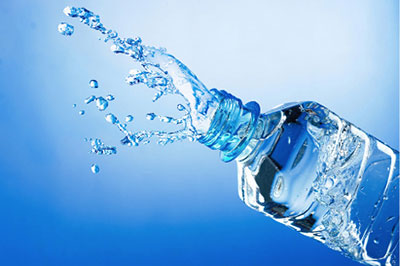Guide M-116
Revised by Rossana Sallenave
College of Agricultural, Consumer, and Environmental Sciences, New Mexico State University
Author: Extension Aquatic Ecology Specialist, Department of Extension Animal Sciences and Natural Resources, New Mexico State University. (Print friendly PDF)
Severe weather and other natural disasters can lead to emergency situations where people are left without running water, or with running water that is not safe to drink or use. The purpose of this guide is to emphasize the importance of having an emergency water supply for yourself and your family, and to describe how to make contaminated water safe for drinking.

© Yap Kee Chan | Dreamstime.com
How Much Water Should Be Stored?
Between 1 and 1.5 gallons of water should be stored for each person and each pet per day. Consider increasing this amount when living in hot climates, or if you have children, sick people, or pregnant or nursing mothers. You should store a 3-day supply of water per person and pet, if possible. If you are storing store-bought water, follow the expiration date printed on the bottle. If you are storing non-store-bought water, you should replace it or use it up every 6 months. Stored water should be kept in a dark, cool place (50–70°F) out of direct sunlight, which can slowly degrade plastic containers. Water containers should not be stored in areas where gasoline, pesticides, or other similar substances are stored because vapors from these materials can penetrate plastic.
There are several methods for storing emergency quantities of potable water for uses such as drinking, cooking, or brushing teeth. Any of the following methods can be used to store water for emergency preparedness. Prolonged or regular use of stored water treated by the following methods is not recommended.
Select and Prepare Storage Containers
Water should be stored before the emergency occurs in food-grade plastic or glass containers. Plastic containers are preferable because glass is breakable and may not withstand the pressure of expanding ice if the water will be stored in a freezer. Restaurants that use large quantities of cooking oil are inexpensive sources of large (5-gallon) plastic containers. Restaurants usually discard the cooking oil containers, so you may be able to get them simply by asking. Avoid metal containers for prolonged storage. This is particularly true when using certain disinfectants. Acid-based disinfectants, for example, can react with certain metals to release contaminants into the water, thus making it unsafe for consumption.
Be certain the storage containers are clean. Containers should first be washed inside and out with soap and hot water. The containers should then be sanitized by adding 1 teaspoon of unscented household bleach to one quart of water. Pour the bleach solution into the container and shake well, making sure that the solution coats the entire inside of the container. Let the container sit with the bleach solution for 30 minutes, then pour out the solution, and rinse thoroughly with clean water. Be sure to completely rinse any cleansing agent from the containers. Ensure that container have tight covers.
When Is It Necessary To Disinfect The Water Before Storage?
Unless there is an emergency “boil water” notice, your drinking water will not need to be disinfected before storing it in containers if it comes from a public supply. However, if there is an emergency in which your municipal water has been contaminated with bacteria or other pathogens, you will need to disinfect it before storing it. If the source of the water you are storing is a private well, spring, or other untested source, you should ensure it is pure before storing it by disinfecting it. Bottled water is also safe to store without purification (disinfection).
|
Table 1. Amount of Bleach Having Either 8.25% or 4–6% Sodium Hypochlorite that Should Be Added to Water to Make It Safe |
||
|
Amount of water |
8.25% sodium hypochlorite* |
4–6% sodium hypochlorite |
|
Amount of bleach to add** |
||
|
1 quart |
2 drops |
2 drops |
|
1 gallon |
6 drops |
8 drops |
|
5 gallons |
30 drops (1/3 teaspoon) |
40 drops (1/2 teaspoon) |
|
*8.25% is the most common household bleach concentration available. |
||
Should Water Be Filtered Before Disinfecting It?
If water is cloudy it will be necessary to filter it before disinfection. Water can be filtered through a clean cloth, paper towel, or coffee filter OR allowed to settle for several hours. The clear water can then be drawn off and disinfected. Filtering and settling are both effective at removing organic debris, such as soil or vegetative debris. If the water source already has a sediment filter installed, this step may not be necessary.
How Can Water Be Disinfected?
Boiling
Water to be stored can be boiled to disinfect it. Boiling for at least 2 minutes (at a rolling boil from the time it starts to cook) will kill most disease-causing organisms. At elevations above 6,500 feet, boil for 3 minutes. If you suspect the presence of harder-to-kill organisms, such as Giardia or Cryptosporidium, boil the water longer. However, do not boil the water more than 5 minutes. Excessive boiling increases the chance of toxicity by concentrating metals, salts, and chemical impurities (such as aluminum, iron, and nitrates) that do not evaporate out.
If more than a few gallons (5–10) are to be stored, it may be impractical to disinfect by boiling. In that case, use a chemical disinfection treatment.
Chemical disinfection
Chemical disinfection treatments such as chlorination and iodine tablets are common ways to purify water. These disinfectants can kill most harmful bacteria and viruses, but are not as effective against more resistant organisms, such as the parasites Cryptosporidium and Giardia. Chlorine dioxide tablets can be effective against Cryptosporidium provided the manufacturer’s instructions are followed correctly. Iodine and iodine-containing tablets are NOT effective against Cryptosporidium.
Chlorination
The procedure for chlorine disinfection of water is sometimes written on the product label. If so, follow the manufacturer’s recommendation. If instructions are not given on the label, check the “Active Ingredient” part of the label to find out the percentage of sodium hypochlorite, and follow Table 1 to know how many drops of bleach to add. The most common household liquid chlorine bleach typically has 8.25% sodium hypochlorite, but concentrations can vary. Using Table 1, add the appropriate amount of bleach to the water using an eyedropper. Do not use bleach that contains a cleansing agent or scent.
Shake or mix the treated water thoroughly, tighten the container lid, and let the water stand for 30 minutes. If at the end of 30 minutes the water does not have a slight chlorine odor, repeat the dosage and allow the water to stand for 15 minutes more.
Following treatment, remove the lid and leave the water exposed to the air. This allows the chlorine to escape into the atmosphere. The water can be stirred or shaken every 15 to 30 minutes to speed this process. The process is complete when there is no more chlorine odor (or taste). In a well-sealed container, water should stay fresh for several months.
Other Chlorination Treatments
Granular calcium hypochlorite can be used to disinfect water by dissolving 1 heaping teaspoon (about 1/4 ounce) in 2 gallons of water. This stock solution can then be used to treat up to 100 gallons of water; use 1 pint of chlorine solution per 12.5 gallons of water.
Chlorine tablets for disinfecting drinking water can be purchased. When instructions are not available, use
1 tablet per quart of water.
As when using chlorine bleach, let the treated water stand for 30 minutes in a sealed container. Then remove the lid and expose the water to air, allowing time for the chlorine odor to escape.
Iodine
For those who are allergic to chlorine or find it objectionable, iodine can be used to effectively disinfect water.
When using tincture of iodine (or common household iodine), add 5 drops of 2% (U.S.P.) iodine to each quart of clear water. For cloudy water, add 10 drops per quart. Let the treated water stand for at least 30 minutes. Iodine is not as chemically volatile as chlorine, so it is harder to remove the odor and taste. However, small quantities are not harmful.
Iodine tablets can be purchased for disinfecting water. If instructions are not available, 1 tablet per quart of water is usually recommended. Hunting or camping supply and military surplus stores are good sources of iodine tablets.
Solar water disinfection (SODIS)
In an emergency situation, water can be disinfected using sunlight. This method has been proven to be a low-cost method to reduce viruses, bacteria, and protozoa in water. Water to be disinfected should be stored in 0.3- to 2-liter (10-oz to 2.1-quart) clear plastic bottles, shaken to oxygenate, then set out in the sun, preferably lying on a reflective surface (such as aluminum foil). Water will be safe to drink after a minimum of 6 hours in bright sunlight. This technique does not work on cloudy water, which will need to be filtered first. The drawbacks of this method are the small volumes of water that can be treated at one time, and the length of time required to treat the water. While this procedure is proven to work for most common water-borne bacteria, viruses, and protozoa, it has not been tested to prove its effectiveness on harder-to-kill organisms (such as oocysts).
Ultraviolet (UV) light disinfection
Portable units can be purchased that deliver a measured dose of UV light to water, which can disinfect small quantities of clear water. As with solar water disinfection, this technique is less effective on cloudy water since pathogens may be shielded from the light by small particles.
References
Centers for Disease Control and Prevention. 2013. Water disinfection [Online]. Available at https://wwwnc.cdc.gov/travel/page/water-disinfection
Centers for Disease Control and Prevention. 2014. The safe water system: Solar disinfection [Online]. Available at https://www.cdc.gov/safewater/solardisinfection.html
Centers for Disease Control and Prevention. 2016. Creating and storing an emergency water supply [Online]. Available at https://www.cdc.gov/healthywater/emergency/drinking/creating-storing-emergency-water-supply.html
Luzi, S., M. Tobler, F. Suter, and R. Meierhofer. 2016. SODIS manual: Guidance on solar water disinfection [Online]. Dübendorf, Switzerland: Eawag. Available at https://www.sodis.ch/methode/anwendung/ausbildungsmaterial/dokumente_material/sodismanual_2016.pdf
Shukla, S., and T. Obreza. 2016. Preparing and storing an emergency safe drinking water supply [Publication #SL220; online]. Gainesville: University of Florida Extension. Available at https://edis.ifas.ufl.edu/ss439
| Original author: Craig Runyan, program coordinator. |
For further reading
M-112: Water Quality for Livestock and Poultry
https://pubs.nmsu.edu/_m/M112/
E-118: Storing Food Safely
https://pubs.nmsu.edu/_e/E118/
E-307: Home Canning of Vegetables
https://pubs.nmsu.edu/_e/E307/
E-322: Drying Foods
https://pubs.nmsu.edu/_e/E322/

Rossana Sallenave is an Extension Aquatic Ecology Specialist at New Mexico State University. She earned her Ph.D. at the University of Guelph in Canada. Her research interests include aquatic ecology and ecotoxicology. Her Extension goals are to educate and assist New Mexicans on issues relating to watershed stewardship and aquatic ecosystem health.
To find more resources for your business, home, or family, visit the College of Agriculture and Home Economics on the World Wide Web at pubs.nmsu.edu
Contents of publications may be freely reproduced for educational purposes. All other rights reserved. For permission to use publications for other purposes, contact pubs@nmsu.edu or the authors listed on the publication.
New Mexico State University is an equal opportunity/affirmative action employer and educator. NMSU and the U.S. Department of Agriculture cooperating.
Revised January 2017 Las Cruces, NM


